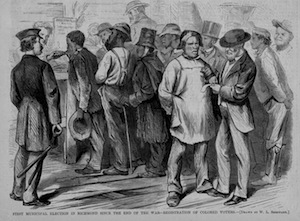19th century prints collection offers views and insights of RVA
June 19, 2014
In the second half of the 19th century, Richmond, Va., was often publicized as the rising – and then fallen – capital of the Confederacy. Much journalism from the city depicted Confederate generals, the raising of monuments and stereotypes of African-American life. But local artist William Ludwell Sheppard also provided images that few people outside the city – and even few white residents – would have been privy to, like a baptism at the First African Church or African-Americans registering to vote for the first time.
The Richmond Nineteenth-Century Print Collection includes more than 140 images of daily life in Richmond from 1853 to 1901, taken from several American and British periodicals that provided extensive coverage of the capital of the Confederacy during and after the Civil War. The prints provide a close look at all facets of life in Richmond in the late 19th century and at the now-extinct field of illustrated journalism.
In a period when photography was still a new medium, news magazines relied on artists to draw or paint scenes to accompany their stories, said Archives Coordinator. In the same way that a photographer might tag along with a reporter to cover a story today, artists would follow reporters to Richmond, sketch the scenes they wanted to capture and then turn them into engravings for the printing process.
“Harper’s Weekly, one of the periodicals whose images we have online, had a Richmond artist contribute images to the magazine,” explained Bonis. “He was William Ludwell Sheppard (1833-1912), a painter from Richmond. VCU folks might know his work as the designer of the Howitzer statue located in Howitzer Park across the street from VCU’s Singleton Center for the Performing Arts.”
Aside from preserving forgotten scenes and complementing news stories, Bonis said the prints in this collection have many research implications.
“The collection has dozens of applications for research – from how African-Americans were depicted in images, sometimes in grotesque stereotypes, to rare views that architectural historians might want of Richmond streetscapes or buildings now lost,” he said. “In fact, one image of a Richmond slave…has already been selected for a research paper. The online collection lets researchers around the world know that we have these kinds of collections.”
A selection of prints are available online through VCU Libraries Digital Collections. The expansive “Richmond and Virginia Print and Map Collection” can also be viewed in .--By Caitlin Puffenberger, VCU Libraries public relations intern
 Chat
Chat